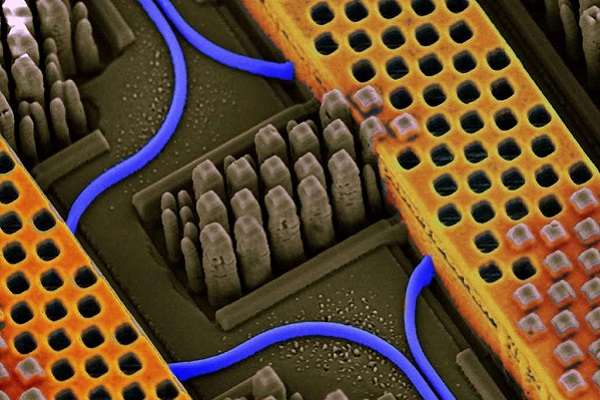IBM ready to commercialise light pulse technology
Big Blue claims data rates of 25Gbps have already been achieved.

IBM has developed a chip that can transmit data using light signals, and claims this will help firms deal with ever increasing volumes of data.
The "silicon nanophotonic" technology utilises light pulses alongside electric signals, which IBM claims allows more information to be carried between servers at a faster rate than traditional chips.
Big Blue has been working on the technology for 10 years and is ready to commercialise the concept as businesses enter the Big Data era.
IBM wants to commercialise the silicon nanophotonic technology using traditional manufacturing processes. The firm has taken a 90nm CMOS fabrication and integrated a number of modules to facilitate the light phase transfers. Additional components include wavelength division multiplexers (WDM), modulators and detectors.
IBM chip shows blue optical waveguides transmitting high-speed optical signals and yellow copper wires carrying high-speed electrical signals
So far nanophotonic technology has exceeded the data rates of 25Gbps per channel, IBM said.
The current method for increasing the performance in datacentres is to facilitate more parallel processes. This is done by packing more cores onto individuals processors and then loading more of these chips into racks and blades.
Sign up today and you will receive a free copy of our Future Focus 2025 report - the leading guidance on AI, cybersecurity and other IT challenges as per 700+ senior executives
IBM claims this type of scaling is unsustainable and not suitable for transferring ExaBytes of data.
The firm claims that optics are "destined" to be utilised in datacentres as it can meet the large bandwidth demands of high-performance computing.
"As it already happened in long-haul communications decades ago when optical fibers replaced copper cables, the copper cables that connect racks in the datacentres are now being replaced by optical fibers," the firm noted on its research page.
"Following the same trend optics can become competitive with copper at shorter and shorter distances eventually leading to optical on-board and may be even on-chip communications."
Dr. Solomon Assefa, research staff member at IBM will reveal further details at the IEEE International Electron Devices Meeting (IEDM) this week
-
 Trump's AI executive order could leave US in a 'regulatory vacuum'
Trump's AI executive order could leave US in a 'regulatory vacuum'News Citing a "patchwork of 50 different regulatory regimes" and "ideological bias", President Trump wants rules to be set at a federal level
-
 TPUs: Google's home advantage
TPUs: Google's home advantageITPro Podcast How does TPU v7 stack up against Nvidia's latest chips – and can Google scale AI using only its own supply?
-
 Put AI to work for IT operations
Put AI to work for IT operationswhitepaper Reduce the cost and complexity of managing hybrid applications
-
 AI in the retail industry is spreading beyond the IT department
AI in the retail industry is spreading beyond the IT departmentNews AI has become a strategic imperative for retailers, delivering marked productivity gains
-
 Maximizing contact center operations with generative AI assistants backed by responsible AI principles
Maximizing contact center operations with generative AI assistants backed by responsible AI principleswhitepaper Reduce the cost and complexity of managing hybrid applications
-
 IBM just launched powerful new open source AI models – here’s what you need to know
IBM just launched powerful new open source AI models – here’s what you need to knowNews Available under the Apache 2.0 license, IBM's Granite 3.0 models are trained on enterprise data and can out-perform the competition
-
 Achieving business outcomes with generative AI
Achieving business outcomes with generative AIWebinar Take your hybrid cloud journey to the next level with generative AI
-
 Wimbledon’s new Catch Me Up AI feature promises to keep fans up to date at the tournament – after it irons out some of the wrinkles
Wimbledon’s new Catch Me Up AI feature promises to keep fans up to date at the tournament – after it irons out some of the wrinklesNews The latest feature to come out of IBM’s partnership with Wimbledon will keep fans engaged from the early stages right through to the final with dynamic player insights
-
 AI demands new ways of data management
AI demands new ways of data managementwhitepaper The data leader’s guide for how to leverage the right databases for applications, analytics and generative AI
-
 AI governance for responsible transparent and explainable AI workflows
AI governance for responsible transparent and explainable AI workflowswhitepaper Build greater trust in your AI